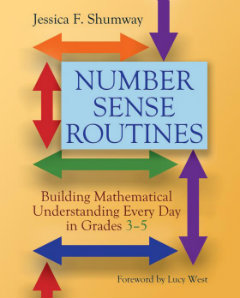Number Sense Routines Build Math Understanding
Number Sense Routines: Building Mathematical Understanding Every Day in Grades 3-5
By Jessica F. Shumway
(Stenhouse, 2018 – Learn more)

After attending the NCTM conference a couple of years ago, I became excited about number talks and what they could do for my students; however, curriculum got in my way and I never implemented them the way I wanted to.

Number Sense Routines is highly readable and easily comprehensible with no educationese or lingo that only “math people” know. Shumway gets straight to the point with clear descriptions and relevant examples to illustrate routines in action. The book is divided into three parts: building number sense through routines, number sense routines themselves, and looking beyond just the routine.
Understanding number sense
The first section describes number sense and how we can vary routines to increase it in our students. Detailing what number sense means and what it looks like when a student has it was quite helpful to me. Even though I thought I knew, the author’s comprehensive list of abilities a person with true number sense would have really solidified my understanding.
Shumway then goes on to explain why these routines create “opportunities for meaningful, connected mathematical understanding.” Isn’t that what we want for all of our students? The focus of the book is on having a set of routines so that number talks don’t become stagnant for you or your students. Shumway concentrates on the warm-up portion of your math block, but that’s okay, because number talks don’t have to always correlate with exactly what you are teaching in that particular unit. I appreciated the reminder and the allowance to not have to find a new routine for each topic of study.
Specifics for a range of categories
The second section details a variety of routines in three categories – visual, counting, and developing flexibility with numbers. First Shumway describes the basic idea behind the routine, and then she gives ways it can be done, complete with helpful images and vignettes from the classroom. Student comments and teacher responses show what the routine looks like in action and what types of responses to a given visual, etc., might result.
I loved how she not only gives questioning strategies teachers can use to get deeper into students’ thinking, but also shows us how to interpret what students are saying, get at what they really understand, and then use what we’ve learned to guide further instruction.
Shumway helpfully includes, prior to the beginning of this section, a chart listing the mathematical content, grade level and suggested number sense routine and points to where you can find the description in the book. This is so great for later reference when you are looking for a particular routine to go with what you are teaching right then.
Putting arguments into words
The final section really focuses on helping students attend to Math Practice 3: Constructing viable arguments and critiquing the reasoning of others. She describes ways to teach students to explain their thinking, be an active listener, have a conversation, and be a supportive classmate.
This part was a good refresher about teaching students how to have conversations about math, the frames students can use to get clarification from peers, and how to be critical thinkers without criticizing others during discussion – something I need to be better about actively practicing and modeling with my class as we get started.
Shumway has our backs
In the conclusion for Number Sense Routines: Building Mathematical Understanding Every Day in Grades 3-5, Jessica Shumway remembers that we are teachers and although we get excited about trying new things, it is hard to get started and stay consistent sometimes. She backs up and gives a starting point for the types of number routines to use, how to build community, and how to engage everyone in the discussion.
When I finished the book, I felt like she had given me all the tools and a final push of encouragement to get into my classroom and really commit to using number sense routines to engage my class of reluctant mathematicians. I couldn’t ask for much more than that.
Rebecca Crockett is a secondary English turned elementary teacher in her twelfth year of teaching. She currently teaches fifth grade math and reading. Since 2013, she has been part of the Idaho Coaching Network whose focus is providing professional development and improving teacher practice around the CCSS. Rebecca lives in north central Idaho with her husband and two children





























Sounds good! Buying it! Thanks! You should read this one https://www.middleweb.com/35000/routines-for-reasoning-in-math-for-all/ and this one https://www.middleweb.com/33992/making-sure-students-master-math-facts/ too! Both really changed the way I think about math.